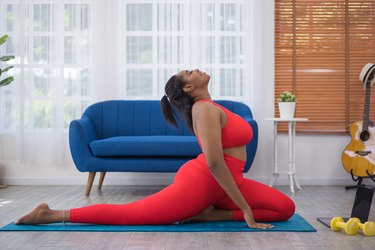
If you've ever done a fast-paced Vinyasa or power yoga class, you know those styles have many benefits, including helping you feel more limber. But if your goal is improving flexibility in the long term, yoga styles like Yin and Hatha, which involve longer hold periods, are your best bets.
"The key difference between Yin practice and other, more active forms of yoga is allowing the body to release in a natural way without engaging the muscles to try and force the body deeper," Kate Lombardo, yoga director and instructor at YogaRenew Teacher Training, tells LIVESTRONG.com.
Video of the Day
Video of the Day
And an April 2014 study in Alternative and Integrative Medicine specifically called out Hatha yoga for helping to improve flexibility of young, healthy females.
Because each pose is held for about 3 to 5 minutes (much longer than in a Vinyasa class), you'll not only stretch larger muscle groups but also target the fascia and other connective tissues, Lombardo says.
Below, Lombardo recommends her top 10 yoga poses for flexibility. But remember: The keys to using yoga for flexibility are holding the pose for an extended period of time and making sure your practice is consistent —- change takes time!
In fact, a January-June 2016 study in the International Journal of Yoga found that male college athletes were able to improve their flexibility with two yoga sessions a week over the course of 10 weeks.
1. Butterfly Pose (Baddha Konasana)
"This pose is great for stretching the hips, inner thighs and back," Lombardo says. If you struggle with the butterfly stretch, start slow and consider adding other moves to help get you there.
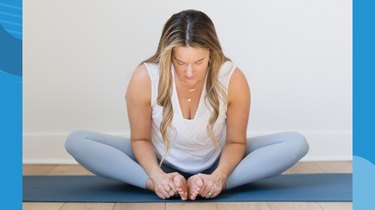
- Begin seated in a comfortable position.
- Bend your knees and bring the soles of your feet to touch.
- Let your knees gently fall open to either side. Allow your knees to come comfortably down toward your mat.
- Breathe in to lift your spine tall. As you breathe out, fold forward from your hips.
- When you come as far forward as your body will allow, let your spine round and relax your head.
2. Caterpillar Pose (Paschimottanasana)
"This pose opens up the entire back of the body," Lombardo says. This includes your hamstrings, calves and all the muscles in your back.
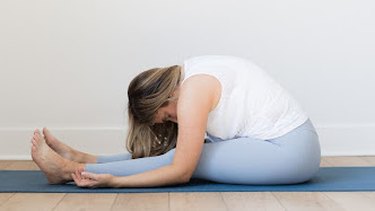
- Begin seated with your legs extended out in front of you. If you feel tension or rounding in your back, sit on a blanket, pillow or yoga block.
- Breathe in and lift your spine tall.
- On your breath out, fold forward at your hips and reach your chest and spine forward.
- Once you’ve come as far forward as your body will allow, relax your neck and allow your spine to round gently.
3. Child's Pose (Balasana)
While many classes include child's pose as a resting place in between more strenuous poses, this seemingly simple pose also helps with flexibility in the hip flexors and lower back.
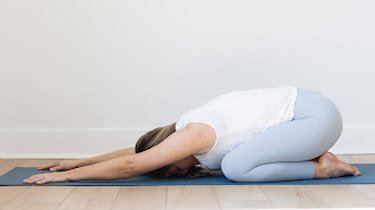
- From a tabletop position on your hands and knees, bring your big toes to touch and bring your hips back to your heels.
- Extend your arms out in front of you with your palms facing down.
- If possible, allow your forehead to come to your mat.
4. Dragon Pose (Utthan Pristhasana)
"This pose [also known as lizard pose] is a wonderful — albeit intense — way to release the psoas and stretch through the hip flexors and quadriceps," Lombardo says. You don't have to start with a 3- to 5-minute hold right away, though: You can slowly build up to it as your flexibility increases.
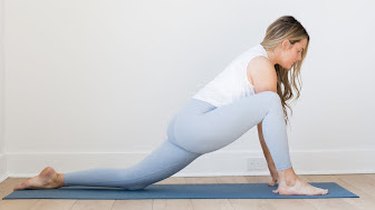
- Begin in a tabletop position on your hands and knees.
- Step your right foot forward in between your hands.
- Align your front knee with your front ankle.
- Shift your hips forward so you lengthen through your back leg and hip flexor. You may need to slide your front foot forward a bit to keep the knee stacked in line with the ankle.
- Allow your back to remain slightly rounded and your neck soft.
- Release out of the pose gently before switching sides.
5. Dragonfly Pose (Parsva Bhuja Dandasana)
This pose is a full-body stretch that opens the hamstrings, inner thighs and the muscles of the back and neck, Lombardo says. To make it a bit more comfortable, she recommends sitting on a block, blanket or pillow.
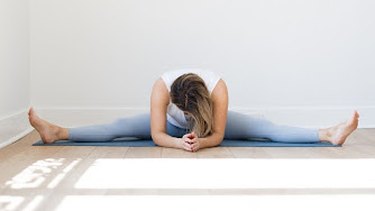
- Begin seated with your legs extended out in front of you.
- Open your legs wide into a V shape, as wide as is comfortable for you. Keep your sit bones pressed to your mat.
- Begin to slowly walk your hands out in front of you, moving as far forward as your body will allow.
- Keep your back slightly arched and your neck comfortable as you gaze down toward your mat.
- To release, gently walk the hands all the way up and use your hands to help bring your legs back together.
6. Melting Heart Pose (Uttana Shishosana)
"This pose [also called puppy pose] is a great way to increase flexibility in the upper spine and shoulders, especially after all the rounding forward we do while looking at our computers and phones," Lombardo says.
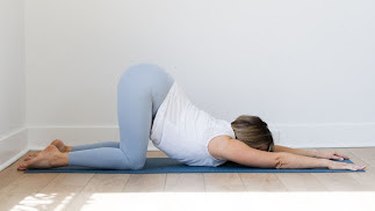
- Begin in a tabletop position on your hands and knees.
- Begin to slowly walk your hands forward and lower your chest to the ground at the same time.
- Relax your forehead down toward your mat.
- Extend your arms forward as far as is comfortable for you and let your palms rest on your mat or on blocks. Relax your head and neck.
- To come out of the pose, slowly walk your hands back toward your torso and into a tabletop position.
7. Sleeping Swan Pose (Adho Mukha Kapotasana)
A slightly more intense version of pigeon pose, this pose is great for stretching the outer hips and hip flexors, Lombardo says.
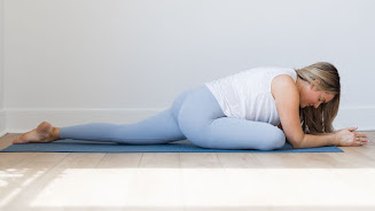
- Begin in a tabletop position on your hands and knees.
- Bring your right foot in and place it down on the mat behind your right wrist.
- Adjust your shin so that it's comfortable for you. The more parallel your shin is to the front edge of your mat, the deeper the stretch will be. You can gently adjust your shin with your hands to make the pose more comfortable.
- Extend your left leg back on your mat with the top of your left foot resting on your mat.
- Stay here or, to deepen the pose, begin to fold your torso toward your mat. Come onto your forearms or rest your head on your palms. To deepen the stretch further, bring your forehead all the way down to the mat and extend your arms out in front of you with palms facing down.
- Keep your neck relaxed and your face resting down toward your mat.
- To come out of the pose, gently walk your hands and upper torso back up.
- Lift your right leg up and back slowly coming back into a tabletop position.
- Make sure to repeat on the other side.
8. Sphinx Pose (Salamba Bhujangasana)
Sphinx pose stretches your upper spine and helps open up the muscles of your upper back and chest, Lombardo says.
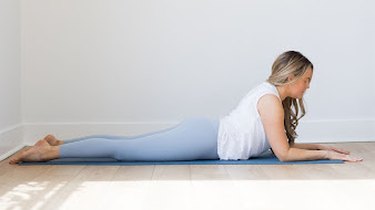
- Begin lying on your belly with your arms by your sides.
- Allow your legs to be about hip-width apart and rest on the tops of your feet.
- Bend your elbows so that your forearms are pressing down onto your mat.
- Press your palms into your mat and spread your fingers wide.
- Lift your chest and upper body up, coming into a slight backbend.
- Work to keep your upper body relaxed. Relax your neck as you gaze softly down toward your mat.
- To come out of the pose, lower your torso to your mat.
9. Square Pose (Agnistambhasana)
Also known as firelog or double pigeon pose, this deep hip opener stretches the outer and inner hips and increases flexibility in the lower back, Lombardo says.
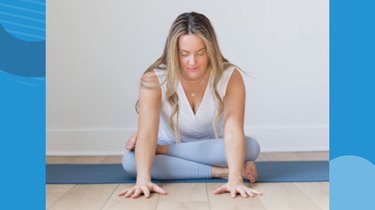
- Sit in a cross-legged position. Gently place your right foot on top of your left knee. Tuck your left foot underneath your right knee.
- Keep your toes in toward your knees.
- Lean forward slightly from your hips. Stop at a point that's comfortable for you.
- Place your palms onto your mat. Keep a slight arch in your back and your neck relaxed.
- Take several deep breaths and relax.
- To come out of the pose, press your palms into your mat and gently uncross your legs. Come back to a cross-legged position.
- Repeat with the opposite leg on top.
10. Half Butterfly Pose (Ardha Titali Asana)
"This pose opens up the inner thigh and outer hip while increasing flexibility in the hamstrings," Lombardo says.
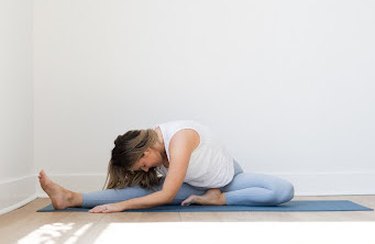
- Begin with your legs extended out in front of you.
- Bend your left leg, placing your left knee on the ground and the sole of your left foot onto your right inner thigh, forming a triangle. You can keep a slight bend in your extended leg knee if you wish.
- Reach your arms up toward the sky to find your length.
- Begin to hinge forward at your hips.
- Reach forward and let your hands rest on your thigh, shin, knee, ankle or foot. You can use a strap if you aren't able to reach all the way down or use blocks to rest your hands on. Keep your back slightly rounded.
- To come out of this pose, rise back up with a flat back.